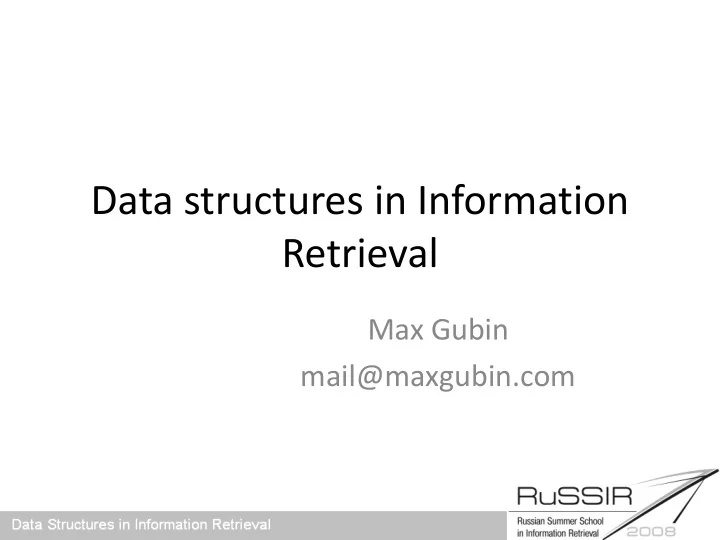

Data structures in Information Retrieval Max Gubin mail@maxgubin.com
Information Retrieval History 4000 1950 2000 BC
Information Retrieval Tasks Types of information: – Text – Sound Mixes… – Image Types of tasks: – Search – Classification/clustering Mixes… – Extraction/Summarization
Toy project Let’s create a toy search engine: Query Search Engine Result Document IR structures inside!!!
Course Outline • Introduction (the problem definition) • Basics (structures and environments) • Building index • Search! • Other data: Language Models and Link Graphs
Hierarchy of data in text IR Collection Document Field1 Field3 Field2 Word A Word B Word C Word D Word E
Linearization (word extraction) (“To”,1,Body,Document1) (“BE”,2,Body,Document1) (“or”,3,Body,Document1) (“not”,4,Body,Document1) (“to”,5,Body,Document1) (“be”,6,Body,Document1)
Document formats • Presentation oriented (PDF, RTF) • Structure Oriented (SGML, HTML, XML)
Encodings • Present all letters of the alphabet • Collation (case) – can be complex in some languages: a A ä Ä ; ئ ﺋﺌﺊﺉ ﯫﯪﲗﰀﲘﰁﲙﱤﱥﲚﱦﱧﲛﳠﯭﯬﯯﯱﯳﯵﯴ Official standard Unicode Latest version 5.10 about 100000 characters: Character codes (codepoints 0 10FFFF) Encoding rules (utf-8, utf-16, utf-32) Algorithms
Words • Morphology agglunative, multiroot, • Abbreviations • Spelling variants • Stop-words How to handle: 1. During document analysis 2. During search
Linearization (complex) (“to”,CAP|stop, 1, Body, Document1) (“be”,UPP|stop, 2, Body,Document1), (“bariumenema”,LOW|stop|ABR, 2,Document1) (“or”,LOW|stop, 3,Body,Document1) (“not”,LOW|stop, 4, Body,Document1) (“to”,LOW|stop, 5, Body, Document1) (“be”,LOW|stop, 6, Body,Document1)
Naïve Scan (grep approach) Query (“to”,CAP|stop, 1, Body, Document1) (“be”,UPP|stop, 2, Body,Document1), (“bariumenema”,LOW|stop|ABR, 2,Document1) Search Result (“or”,LOW|stop, 3,Body,Document1) Document (“not”,LOW|stop, 4, Body,Document1) (“to”,LOW|stop, 5, Body, Document1) (“be”,LOW|stop, 6, Body,Document1) • Have the whole context for analysis • Match current hardware architecture • Usually can be easily parallelized
Adding index Two meanings of index: • Taxonomy that accelerates human search • Special data structure that accelerate data access
Using Standard Database Dictionary Doctable Word ID Document ID to 1 Hamlet 1 Positions be 2 Introduction to… 2 not 4 WordID DocID Flags Fields Pos Dive into Python 3 or 3 1 1 CAP BODY 1 2 1 CAP BODY 2 3 1 BODY 3 4 1 BODY 4 1 1 BODY 5 2 1 BODY 6 SELECT DocTable.Document FROM Dictionary,Doctable,Positions WHERE Dictionary.word=? AND Dictionary.ID=Positions.WordID AND Doctable.ID=Positions.DocID
Bag of words Dictionary Doctable Word ID Document ID to 1 Hamlet 1 Positions be 2 Introduction to… 2 not 4 WordID DocID Flags Fields Count Dive into Python 3 or 3 1 1 CAP BODY 2 2 1 CAP BODY 2 3 1 BODY 1 4 1 BODY 1
Problems with General Purpose Databases 1. Size 2. Speed build 3. Speed search This is a tool for another task
Matrix representation 1 2 3 Simple example a 1 0 0 and 0 0 1 1. Dad is reading a book are 0 0 1 2. Mom is watching TV at 0 0 1 3. Dad and Mom are at home book 1 0 0 Dad 1 0 1 Mom 0 1 1 is 1 1 0 reading 1 0 0 home 0 0 1 TV 0 1 0
Main IR structure A sparse n-dimensional matrix in different presentations is “ THE MAIN IR STRUCTURE ” Search – inverted index Language models – table of probabilities Link analysis – Adjacency matrix
Sparseness of the matrix Example: N - 1 mln documents Ds - 1000 words/document D – 500 000 words in dictionary |Word/Document matrix| = D*N = 500 bln Words in collection = 1 mln * 1000 = 1 bln Only 0.2% elements in the matrix are not 0
Inverted file Dictionary Posting lists Dad 1,3 Mom 2,3 2 TV
Signature file Signatures for words Doc Signature = OR words (function) Dad 00000001 1 00110001 Mom 00001000 2 01011000 TV 10000000 3 10001001 watching 00001000 football 00001000
Signature file (Search) Query=“MomDad” 1 00110001 q_s = 00001001 2 01011000 3 10001001 for doc in Document_Signatures: if doc.signature & q_s = q_s: ScanDocument(doc.id) An old structure = hash + bloom filter + scan
IR Packages • Lucene (http://lucene.apache.org/) • Terrier (http://ir.dcs.gla.ac.uk/terrier/) • Lemur & Indri (http://www.lemurproject.org/) • Zettair (http://www.seg.rmit.edu.au/zettair/ ) • Zebra (http://www.indexdata.dk/zebra/)
Search speed Inverted File Search speed Signature file Naïve Scan Collection size
Speed (Size) depends on • Algorithm • Size of data • Hardware
Algorithm complexity • Storage complexity (How much memory we need) • Time complexity (How many operations we need)
O(f(n)) notation x(n) is O(f(n)) if x(n) ≤ C* f(n), C – const n →∞ O(n) O(log(n)) O(1)
Structure characteristics • Theoretical: Processing algorithm complexity = • Practical: – Memory access pattern – Parallelization
Summary • IR is old • Main Structure is sparse matrix • Index = Inverted file • Speed & Size
Q&A
Recommend
More recommend